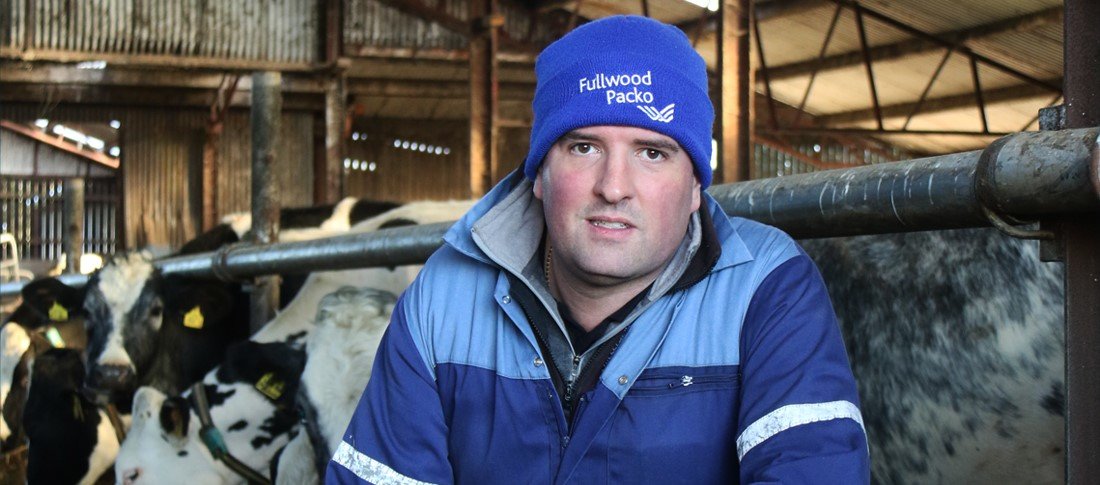How to make the most of your product for profit is farming 101. For Northern Ireland dairy farmer William Maxwell, getting his herd to meet its genetic potential is led entirely by nutrition. His farming philosophy is based on one simple truth: quality input leads to quality output.
This article originally appeared in the February 2020 issue of Dairy Farmer and has been adapted for our blog with permission.
“If you get the nutrition right, everything else follows through.”
Ballygreenan Farm is home to a 55 crossbred cows on an Autumn block calving system. An impressive quality contract of 7,500 litres, achieving an average of 4% butterfat and 3.3% protein content.
With the farm at stocking capacity and expansion unlikely, everyday operations are handled by three generations of the Maxwell family.
William Maxwell explains, “Between the three of us, we can keep everything going. However, the cowherd must be efficient to maximise output and to minimise labour inputs on our limited system.”
Working genetics
The starting point of optimising herd efficiency is a cow that will pull her own weight. This means easy fleshing, easy calving, high fertility, good milk production and herd longevity.
How so? Crossbreeding the ‘working clothes’ genetics. The result? A herd that untaps the vigorous hybrid of British Friesians, Shorthorns and Swedish Reds. The advantages? Being able to hold body condition more easily, improving conception rates and cows averaging an additional 1.5 lactations. Another distinct upside is that by prioritising calving ease, most of the herd calving has gone unassisted.
Mr Maxwell says, “From a labour point of view, we need the genetic assurance that our cows are going to be able to calve themselves.
“From a production point of view, we have to make the most of everything we have.”
Feeding for genetic potential
From birth to breeding to beyond, optimising herd performance is a continuous cycle driven by nutrition. At calving, cows are milked to ensure calves receive five litres of colostrum, plus an additional 24 hours on the cow to absorb any antibodies that may be in the milk as it transitions.
Then it’s making sure the calves are bucket fed twice a day. That’s three litres of milk with 300 grams of milk powder per feed.
William explains, “From the moment they’re being bucket fed, we provide ad-lib pellets and straw to help with rumen development.
“Starting at six weeks, I begin to step down milk feedings and quantity, but keep the milk concentration the same until calves are weaned at 11 weeks. I use the Feed for Growth app to track growth rates, targeting a gain of 0.8kg per day.”
Supplementation for performance
It’s all about the quality. Throughout their development, heifers are supplied with high-quality forage.
The benefit? Adequate body condition to get into calf at 15 months of age. Once they calve down at 24 months and enter the milking herd, they are supplemented with a blend that includes a good balance of nutrients including Megalac.
This is a rumen-protected fat supplement with a blend of C16:0 (palmitic acid) and the critical C18:1 (oleic acid). According to Volac Wilmar Feed Ingredients’ Dr Richard Kirkland, C18:1 is crucial during the early lactation period. It’s a key fatty acid to deliver to the small intestine for absorption as it increases the partitioning of energy and nutrients to improve body condition.
“C18:1 also directly influences the development of fertilised eggs and improves digestibility of total diet fat to provide an additional energy boost”, adds Dr Kirkland.
He continues, “For cows in the post-peak period of lactation, supplementing with products containing high levels of C16:0 will increase partitioning of nutrients to milk, which in turn will improve milk and milk fat production.”
So, to unleash a herd’s genetic potentialit’s essential to supply high-quality nutrition from birth and through lactation.
As Mr Maxwell concludes, “It doesn’t matter what our genetics are – if the herd doesn’t have the fuel they need, they will fall short.
“If a cow is open because our nutrition wasn’t right, that cuts into milk production profit and is an additional cost. Our nutritional programme is an investment to ensure cow performance to protect our bottom line.”
